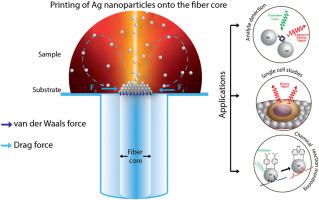当前位置:
X-MOL 学术
›
Anal. Chim. Acta
›
论文详情
Our official English website, www.x-mol.net, welcomes your feedback! (Note: you will need to create a separate account there.)
Optically printed plasmonic fiber tip-assisted SERS-based chemical sensing and single biological cell studies
Analytica Chimica Acta ( IF 5.7 ) Pub Date : 2024-06-25 , DOI: 10.1016/j.aca.2024.342903 Monisha K , Suresh K , Aseefhali Bankapur , Sajan D. George
Analytica Chimica Acta ( IF 5.7 ) Pub Date : 2024-06-25 , DOI: 10.1016/j.aca.2024.342903 Monisha K , Suresh K , Aseefhali Bankapur , Sajan D. George

|
Precise localized printing of plasmonic nanoparticles at desired locations can find a plethora of applications in diverse areas, including nanophotonics, nanomedicine, and microelectronics. The focused laser beam-assisted optical printing technique has illustrated its potential for the localized printing of differently shaped plasmonic particles. However, the technique is either time-consuming or often requires focused optical radiation, limiting its practical applications. While the optothermal printing technique has recently emerged as a promising technique for the direct and rapid printing of plasmonic nanoparticles onto transparent substrates at lower laser intensities, its potential to print the plasmonic nanoparticles to the core of the optical fiber platforms and utilize it for biological cell trapping as well as an analytical platform remains unexplored. Herein, we demonstrate the thermal-convection-assisted printing of the Ag plasmonic nanoparticles from the plasmonic colloidal solution onto the core of single-mode optical fiber and its multi-functional applications. The direct printing of plasmonic structure on the fiber core via the thermal-convection mechanism is devoid of the requirement of any additional chemical ligand to the fiber core. Further, we demonstrated the potential of the developed plasmonic fiber probe as a multifunctional surface-enhanced Raman spectroscopic (SERS) platform for sensing, chemical reaction monitoring, and single-cell studies. The developed SERS fiber probe is found to detect crystal violet in an aqueous solution as low as 100 pM, with a plasmonic enhancement of 10. Additionally, the capability of the fiber-tip platform to monitor the surface plasmon-driven chemical reaction of 4-nitrothiophenol (4NTP) dimerizing into p, p’-dimercaptoazobenzene (DMAB) is demonstrated. Further, the versatility of the fiber probe as an effective platform for opto-thermophoretic trapping of single biological cells such as yeast, along with its Raman spectroscopic studies, is also shown here. In this study, we illustrate for the first time the optothermal direct printing of plasmonic nanoparticles onto the core of a single-mode fiber. Further, the study demonstrates that such plasmonic nanoparticle printed fiber tip can act as a multi-functional analytical platform for optothermally trap biological particles as well as monitoring plasmon-driven chemical reactions. In addition, the plasmonic fiber tip can be used as a cost-effective SERS analytical platform and is thus expected to find applications in diverse areas.
中文翻译:

光学印刷等离子体光纤尖端辅助基于 SERS 的化学传感和单生物细胞研究
在所需位置精确定位等离子体纳米粒子可以在不同领域找到大量应用,包括纳米光子学、纳米医学和微电子学。聚焦激光束辅助光学印刷技术已经展示了其在不同形状的等离子体粒子的局部印刷方面的潜力。然而,该技术要么耗时,要么通常需要聚焦光辐射,限制了其实际应用。虽然光热打印技术最近已成为一种有前途的技术,可以在较低的激光强度下将等离子体纳米颗粒直接快速地打印到透明基板上,但其将等离子体纳米颗粒打印到光纤平台的核心并将其用于生物细胞的潜力捕获以及分析平台仍有待探索。在此,我们展示了从等离子体胶体溶液中热对流辅助打印银等离子体纳米颗粒到单模光纤芯上及其多功能应用。通过热对流机制将等离子体结构直接印刷在纤维芯上,不需要任何额外的化学配体到纤维芯上。此外,我们还展示了所开发的等离子体光纤探针作为多功能表面增强拉曼光谱(SERS)平台的潜力,用于传感、化学反应监测和单细胞研究。研究发现,所开发的 SERS 光纤探针可以检测低至 100 pM 的水溶液中的结晶紫,等离子体增强为 10。 此外,还证明了光纤尖端平台能够监测表面等离子体驱动的 4-硝基苯硫酚 (4NTP) 二聚成对,对'-二巯基偶氮苯 (DMAB) 的化学反应。此外,这里还展示了光纤探针作为单个生物细胞(例如酵母)的光热泳捕获有效平台的多功能性及其拉曼光谱研究。在这项研究中,我们首次说明了将等离子体纳米颗粒光热直接打印到单模光纤纤芯上。此外,该研究表明,这种等离子体纳米颗粒印刷纤维尖端可以作为多功能分析平台,用于光热捕获生物颗粒以及监测等离子体驱动的化学反应。此外,等离子体光纤尖端可用作经济高效的SERS分析平台,因此有望在不同领域得到应用。
更新日期:2024-06-25
中文翻译:

光学印刷等离子体光纤尖端辅助基于 SERS 的化学传感和单生物细胞研究
在所需位置精确定位等离子体纳米粒子可以在不同领域找到大量应用,包括纳米光子学、纳米医学和微电子学。聚焦激光束辅助光学印刷技术已经展示了其在不同形状的等离子体粒子的局部印刷方面的潜力。然而,该技术要么耗时,要么通常需要聚焦光辐射,限制了其实际应用。虽然光热打印技术最近已成为一种有前途的技术,可以在较低的激光强度下将等离子体纳米颗粒直接快速地打印到透明基板上,但其将等离子体纳米颗粒打印到光纤平台的核心并将其用于生物细胞的潜力捕获以及分析平台仍有待探索。在此,我们展示了从等离子体胶体溶液中热对流辅助打印银等离子体纳米颗粒到单模光纤芯上及其多功能应用。通过热对流机制将等离子体结构直接印刷在纤维芯上,不需要任何额外的化学配体到纤维芯上。此外,我们还展示了所开发的等离子体光纤探针作为多功能表面增强拉曼光谱(SERS)平台的潜力,用于传感、化学反应监测和单细胞研究。研究发现,所开发的 SERS 光纤探针可以检测低至 100 pM 的水溶液中的结晶紫,等离子体增强为 10。 此外,还证明了光纤尖端平台能够监测表面等离子体驱动的 4-硝基苯硫酚 (4NTP) 二聚成对,对'-二巯基偶氮苯 (DMAB) 的化学反应。此外,这里还展示了光纤探针作为单个生物细胞(例如酵母)的光热泳捕获有效平台的多功能性及其拉曼光谱研究。在这项研究中,我们首次说明了将等离子体纳米颗粒光热直接打印到单模光纤纤芯上。此外,该研究表明,这种等离子体纳米颗粒印刷纤维尖端可以作为多功能分析平台,用于光热捕获生物颗粒以及监测等离子体驱动的化学反应。此外,等离子体光纤尖端可用作经济高效的SERS分析平台,因此有望在不同领域得到应用。











































 京公网安备 11010802027423号
京公网安备 11010802027423号